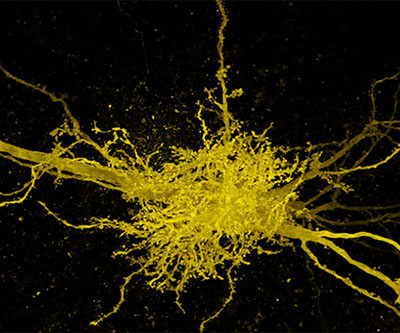
Human mossy fiber synapse.
Credit: McBain Lab, NICHD
For decades, neuroscientists have relied on animal models to understand how the nervous system works to enable basic bodily functions, as well as complex skills like learning and memory. These processes depend on communication between neurons and the transfer of information at synapses, the junctions between neurons. It remains unclear whether the properties of different types of synapses discovered in mice are relevant to human synapses and neurological conditions and diseases that occur in people.
- Recent work led by the McBain Lab found that the properties of synapses that help form long-term memories and aid in learning are similar between mice and people. Specifically, the researchers compared mossy fiber synapses, which help form contextual memories, in mice to those in people by studying human brain samples that were surgically removed as part of epilepsy treatment.
- Overall, their findings demonstrate that the basic, core properties of the mossy fiber synapse are similar between mouse and human despite more than 100 million years of evolution.
- The study highlights the usefulness of animal models in neuroscience research and provides assurance that prior rodent research on the mossy fiber synapse remains applicable to human health and disease.
NICHD authors of the paper include Kenneth A. Pelkey, Geoffrey A. Vargish, Daniela Calvigioni, Xiaoqing Yuan, Steven Hunt, Ramesh Chittajallu, and Chris J. McBain. The team also included researchers from the National Institute of Neurological Disorders and Stroke and the National Institute of Mental Health.
Learn more about the Neurosciences group: https://www.nichd.nih.gov/about/org/dir/affinity-groups/neurosciences
 BACK TO TOP
BACK TO TOP